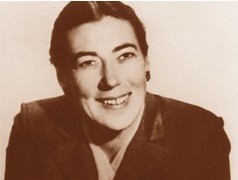Evelyn Hooker (Researcher/Psyhologist)
 Evelyn Hooker (September 2, 1907–November 18, 1996) was a North American psychologist most notable for her 1957 paper "The Adjustment of the Male Overt Homosexual" in which she administered psychological tests to groups of self-identified homosexuals and heterosexuals and asked experts, based on those tests alone, to select the homosexual people.
Evelyn Hooker (September 2, 1907–November 18, 1996) was a North American psychologist most notable for her 1957 paper "The Adjustment of the Male Overt Homosexual" in which she administered psychological tests to groups of self-identified homosexuals and heterosexuals and asked experts, based on those tests alone, to select the homosexual people.
The experiment, which other researchers subsequently repeated, demonstrates that most self-identified homosexuals are no worse in social adjustment than the general population.
She was born Evelyn Gentry in North Platte, Nebraska, and grew up with 8 brothers and sisters in the Colorado Plains. When she was 13, her family moved to Sterling, Colorado.
In 1924 she became a student at the University of Colorado while working as a maid for a rich Boulder family. Her mentor, Dr Karl Munzinger, guided her in her challenge of the then prevalent psychological theory of behaviourism.
He invited her to write her own case history. After receiving her Masters degree, she became one of 11 women involved in the PhD program in psychology at Johns Hopkins University, Baltimore, Maryland, having been refused referral to Yale. She was awarded her PhD in 1932.
In her early career, she wasn't especially interested in the psychology of lesbians or gays. After teaching for only one year at the Maryland College for Women, she contracted tuberculosis and spent the next year in a sanatorium in Arizona.
In 1937 Evelyn received a fellowship to go to Europe. She enrolled at the Berlin Institute of Psychotherapy. She witnessed mass hysteria on the triumphant return of Hitler to Berlin after the Anschluss.
However, during the 1940s, she first became interested in what would turn out to be her life's work. In 1942 while a teacher at UCLA, Evelyn married writer Don Caldwell. She became close to one of her students, Sam From, who introduced her in 1943 to the gay and lesbian subculture of the time. He challenged her to scientifically study "people like him."
Despite the social, moral and scientific climate of the post-war period, Hooker became increasingly convinced that most gay men were perfectly socially adjusted and that this could be proven through scientific tests.
Over the next two decades, she became established professionally. In 1948 she divorced her husband and moved to a guest cottage at the Salter Avenue home of Edward Hooker, professor of English at UCLA and poetry scholar.
They married in London in 1951. In the mid 50s Christopher Isherwood became their neighbor and they became friends. Sam From died in a car accident in 1956, just before her ground-breaking research was published. Hooker's husband died in January 1957 of a heart attack.
The 1960s saw her work win a wider audience, and her conclusions were taken up by the gay rights movement. In 1961 Hooker was invited to lecture in Europe and in 1967, the director of the National Institute of Mental Health (NIMH) asked her to produce a report on what the institution should do about homosexual men.
Richard Nixon's election in 1969 delayed the publication of the report which was published by a magazine and without authorisation in 1970. The report recommended the decriminalisation of homosexuality and the provision of similar rights to both homosexual and heterosexual people. The burgeoning gay rights movement seized on this.
She retired from her research at the age of 63 and opened a private practice. Most of her clients were gay men and lesbians.
Hooker died at her home in Santa Monica, California in 1996, at the age of 89.
Although, since 1954, Hooker had collected data about her homosexual friends, she felt this was of little value because of the lack of scientific rigor attached to the gathering of this data. She applied for a grant from the NIMH, which she received.
She gathered two groups of men: one group would be exclusively homosexual, the other exclusively heterosexual. She contacted the Mattachine Society to find homosexual men. She had greater difficulty finding heterosexual men. She also had to use her home to conduct the interview to protect people's anonymity.
Hooker used three different psychological tests for her study: the TAT, the Make-a-Picture-Story test (MAPS test), and the Rorschach inkblot test.
After a year of work, Hooker presented a team of 3 expert evaluators with 60 unmarked psychological profiles. She decided to leave the interpretation of her results to other people so as to avoid her own prejudice.
First, she contacted Bruno Klopfer, an expert on Rorschach tests to see if he would be able to identify the sexual orientation of people through their results at those tests. His ability to differentiate was no better than chance. Then Edwin Shneidman, creator of the MAPS test, also analyzed the 60 profiles. It took him six months and he too found that both groups were highly similar in their psychological make-up.
The third expert was Dr Mortimer Mayer who was so certain he would be able to tell the two groups apart that he went through the process twice. The three evaluators agreed that in terms of adjustment, there were no differences between the members of each group.
In 1956, Hooker presented the results of her research in a paper delivered to the American Psychological Association's convention in Chicago.
Her studies contributed to a change in the attitudes of the psychological community towards homosexuality and to the American Psychiatric Association's decision to remove homosexuality from its handbook of disorders in 1973. This in turn helped change the attitude of society at large.
Related Links:
Evelyn Hooker on Wikipedia